Novel Montmorillonite/TiO2/MnAl-Mixed Oxide Composites Prepared from Inverse Microemulsions as Combustion Catalysts
Abstract
:1. Introduction
2. Materials and Methods
2.1. Materials
2.2. Methods
3. Results and Discussion
3.1. Characterization of Composites
3.2. Catalytic Testing
4. Conclusions
Acknowledgments
Author Contributions
Conflicts of Interest
References
- Everaert, K.; Baeyens, J. Catalytic combustion of volatile organic compounds. J. Hazard. Mater. B 2004, 109, 113–139. [Google Scholar] [CrossRef] [PubMed]
- Storaro, L.; Ganzerla, R.; Lenarda, M.; Zanoni, R.; Jiménez López, A.; Olivera-Pastor, P.; Rodróguez Castellón, E. Catalytic behavior of chromia and chromium-doped alumina pillared clay materials for the vapor phase deep oxidation of chlorinated hydrocarbons. J. Mol. Catal. A 1997, 115, 329–338. [Google Scholar] [CrossRef]
- Bahranowski, K.; Bielańska, E.; Janik, R.; Machej, T.; Serwicka, E.M. LDH-derived catalysts for complete oxidation of volatile organic compounds. Clay Miner. 1999, 34, 67–77. [Google Scholar] [CrossRef]
- Kovanda, F.; Jiratova, K.; Rymes, J. Characterization of activated Cu/Mg/Al hydrotalcites and their catalytic activity in toluene combustion. Appl. Clay Sci. 2001, 18, 71–80. [Google Scholar] [CrossRef]
- Gandía, L.M.; Vicente, M.A.; Gil, A. Complete oxidation of acetone over manganese oxide catalysts supported on alumina- and zirconia-pillared clays. Appl. Catal. B 2002, 38, 295–307. [Google Scholar] [CrossRef]
- Serwicka, E.M.; Bahranowski, K. Environmental catalysis by tailored materials derived from layered minerals. Catal. Today 2004, 90, 85–92. [Google Scholar] [CrossRef]
- Dula, R.; Janik, R.; Machej, T.; Stoch, J.; Grabowski, R.; Serwicka, E.M. Mn-containing catalytic materials for the total combustion of toluene: The role of Mn localisation in the structure of LDH precursor. Catal. Today 2007, 119, 327–331. [Google Scholar] [CrossRef]
- Lamonier, J.F.; Boutoundou, A.B.; Gennequin, C.; Pérez-Zurita, M.J.; Siffert, S.; Aboukais, A. Catalytic removal of toluene in air over Co-Mn-Al nano-oxides synthesized by hydrotalcite route. Catal. Lett. 2007, 118, 165–172. [Google Scholar] [CrossRef]
- Mishra, T.; Mohapatra, P.; Parida, K.M. Synthesis, characterisation and catalytic evaluation of iron-manganese mixed oxide pillared clay for VOC decomposition reaction. Appl. Catal. B 2008, 79, 279–285. [Google Scholar] [CrossRef]
- Chen, M.; Fan, L.; Qi, L.; Luo, X.; Zhou, R.; Zheng, X. The catalytic combustion of VOCs over copper catalysts supported on cerium-modified and zirconium-pillared montmorillonite. Catal. Commun. 2009, 10, 838–841. [Google Scholar] [CrossRef]
- Palacio, L.A.; Velásquez, J.; Echavarría, A.; Faro, A.; Ribeiro, F.R.; Ribeiro, M.F. Total oxidation of toluene over calcined trimetallic hydrotalcites type catalysts. J. Hazard. Mater. 2010, 177, 407–413. [Google Scholar] [CrossRef] [PubMed]
- Aguilera, D.A.; Perez, A.; Molina, R.; Moreno, S. Cu-Mn and Co-Mn catalysts synthesized from hydrotalcites and their use in the oxidation of VOCs. Appl. Catal. B 2011, 104, 144–150. [Google Scholar] [CrossRef]
- Kovanda, F.; Jirátová, K. Supported layered double hydroxide-related mixed oxides and their application in the total oxidation of volatile organic compounds. Appl. Clay Sci. 2011, 53, 305–316. [Google Scholar] [CrossRef]
- Genty, E.; Cousin, R.; Capelle, S.; Gennequin, C.; Siffert, S. Catalytic oxidation of toluene and CO over nanocatalysts derived from hydrotalcite-like compounds (X62+Al23+): Effect of the bivalent cation. Eur. J. Inorg. Chem. 2012, 2802–2811. [Google Scholar] [CrossRef]
- Li, D.; Li, C.S.; Suzuki, K. Catalytic oxidation of VOCs over Al- and Fe-pillared montmorillonite. Appl. Clay Sci. 2013, 77–78, 56–60. [Google Scholar] [CrossRef]
- Machej, T.; Serwicka, E.M.; Zimowska, M.; Dula, R.; Michalik-Zym, A.; Napruszewska, B.; Rojek, W.; Socha, R. Cu/Mn-based mixed oxides derived from hydrotalcite-like precursors as catalysts for methane combustion. Appl. Catal. A 2014, 474, 87–94. [Google Scholar] [CrossRef]
- Michalik-Zym, A.; Dula, R.; Duraczyńska, D.; Kryściak-Czerwenka, J.; Machej, T.; Socha, R.P.; Włodarczyk, W.; Gaweł, A.; Matusik, J.; Bahranowski, K.; et al. Active, selective and robust Pd and/or Cr catalysts supported on Ti-, Zr- or [Ti,Zr]-pillared montmorillonites for destruction of chlorinated volatile organic compounds. Appl. Catal. B 2015, 174, 293–307. [Google Scholar] [CrossRef]
- Liang, X.; Qi, F.; Liu, P.; Wei, G.; Su, X.; Ma, L.; He, H.; Lin, X.; Xi, Y.; Zhu, J.; et al. Performance of Ti-pillared montmorillonite supported Fe catalysts for toluene oxidation: The effect of Fe on catalytic activity. Appl. Clay Sci. 2016, 132–133, 96–104. [Google Scholar] [CrossRef]
- Napruszewska, B.D.; Michalik-Zym, A.; Dula, R.; Bielanska, E.; Rojek, W.; Machej, T.; Socha, R.P.; Lityńska-Dobrzyńska, L.; Bahranowski, K.; Serwicka, E.M. Composites derived from exfoliated Laponite and Mn-Al hydrotalcite prepared in inverse microemulsion: A new strategy for design of robust VOCs combustion catalysts. Appl. Catal. B 2017, 211, 46–56. [Google Scholar] [CrossRef]
- Krishnamoorthy, S.; Rivas, J.A.; Amiridis, M.D. Catalytic Oxidation of 1,2-Dichlorobenzene over Supported Transition Metal Oxides. J. Catal. 2000, 193, 264–272. [Google Scholar] [CrossRef]
- Liu, Y.; Luo, M.; Wei, Z.; Xin, Q.; Ying, P.; Li, C. Catalytic oxidation of chlorobenzene on supported manganese oxide catalysts. Appl. Catal. B 2001, 29, 61–67. [Google Scholar] [CrossRef]
- Morales, M.R.; Barbero, B.P.; Lopez, T.; Moreno, A.; Cadús, L.E. Evaluation and characterization of Mn-Cu mixed oxide catalysts supported on TiO2 and ZrO2 for ethanol total oxidation. Fuel 2009, 88, 2122–2129. [Google Scholar] [CrossRef]
- Doggali, P.; Teraoka, Y.; Mungse, P.; Shah, I.K.; Rayalua, S.; Labhsetwar, N. Combustion of volatile organic compounds over Cu-Mn based mixed oxide type catalysts supported on mesoporous Al2O3, TiO2 and ZrO2. J. Mol. Catal. A 2012, 358, 23–30. [Google Scholar] [CrossRef]
- Zhu, X.; Zhang, S.; Yu, X.; Zhu, X.; Zheng, C.; Gao, X.; Luo, Z.; Cen, K. Controllable synthesis of hierarchical MnOX/TiO2 composite nanofibers for complete oxidation of low-concentration acetone. J. Hazard. Mater. 2017, 337, 105–114. [Google Scholar] [CrossRef] [PubMed]
- Bahranowski, K.; Gaweł, A.; Klimek, A.; Michalik-Zym, A.; Napruszewska, B.D.; Nattich-Rak, M.; Rogowska, M.; Serwicka, E.M. Influence of purification method of Na-montmorillonite on textural properties of clay mineral composites with TiO2 nanoparticles. Appl. Clay Sci. 2017, 140, 75–80. [Google Scholar] [CrossRef]
- Bellezza, F.; Cipiciani, A.; Costantino, U.; Nocchetti, M.; Posati, T. Hydrotalcite-like nanocrystals from water-in-oil microemulsions. Eur. J. Inorg. Chem. 2009, 18, 2603–2611. [Google Scholar] [CrossRef]
- Venugopal, B.R.; Sen, S.; Shivakumara, C.; Rajamathi, M. Delamination of surfactant intercalated smectites in alcohols: Effect of chain length of the solvent. Appl. Clay Sci. 2006, 32, 141–146. [Google Scholar] [CrossRef]
- Sterte, J. Synthesis and properties of titanium oxide cross-linked montmorillonite. Clays Clay Miner. 1986, 34, 658–664. [Google Scholar] [CrossRef]
- Ryu, W.H.; Han, D.W.; Kim, W.K.; Kwon, H.S. Facile route to control the surface morphologies of 3D hierarchical MnO2 and its Al self-doping phenomenon. J. Nanopart. Res. 2011, 13, 4777–4784. [Google Scholar] [CrossRef]
- Ovadyahu, D.; Lapides, I.; Yariv, S. Thermal analysis of tributylammonium montmorillonite and Laponite. J. Therm. Anal. Calorim. 2007, 87, 125–134. [Google Scholar] [CrossRef]
- Perrichon, V.; Durupty, M.C. Thermal stability of alkali metals deposited on oxide supports and their influence on the surface area of the support. Appl. Catal. 1988, 42, 217–227. [Google Scholar] [CrossRef]
- Bondioli, F.; Corradi, A.B.; Manfredini, T.; Leonelli, C.; Bertoncello, R. Nonconventional synthesis of praseodymium-doped ceria by flux method. Chem. Mater. 1999, 12, 324–330. [Google Scholar] [CrossRef]
- Thommes, M.; Kaneko, K.; Neimerk, A.V.; Olivier, J.P.; Rodriguez-Reinozo, F.; Rouquerol, J.; Sing, K.S.W. Physisorption of gases with special reference to the evaluation of surface area and pore size distribution (IUPAC Technical Report). Pure Appl. Chem. 2015, 879, 1051–1069. [Google Scholar] [CrossRef]
- Van Der Voort, P.; Ravikovitch, P.I.; De Jong, K.P.; Neimark, A.V.; Janssen, A.H.; Benjelloun, M.; Van Bavel, E.; Cool, P.; Weckhuysen, B.M.; Vansant, E.F. Plugged hexagonal templated silica: A unique micro- and mesoporous composite material with internal silica nanocapsules. Chem. Commun. 2002, 1010–1011. [Google Scholar] [CrossRef]
- Kruk, M.; Jaroniec, M.; Joo, S.H.; Ryoo, R. Characterization of regular and plugged SBA-15 silicas by using adsorption and inverse carbon replication and explanation of the plug formation mechanism. J. Phys. Chem. 2003, 107, 2205–2213. [Google Scholar] [CrossRef]
- Kapteijn, F.; Singoredjo, L.; Andreini, A. Activity and selectivity of pure manganese oxides in the selective catalytic reduction of nitric oxide with ammonia. Appl. Catal. B 1994, 3, 173–189. [Google Scholar] [CrossRef]
- Stobbe, E.R.; de Boer, B.A.; Geus, J.W. The reduction and oxidation behaviour of manganese oxides. Catal. Today 1999, 47, 161–167. [Google Scholar] [CrossRef]
- Gil, A.; Gandía, L.M.; Korili, S.A. Effect of the temperature of calcination on the catalytic performance of manganese- and samarium-manganese-based oxides in the complete oxidation of acetone. Appl. Catal. A 2004, 274, 229–235. [Google Scholar] [CrossRef]
- Fu, X.; Feng, J.; Wang, H.; Ng, K.M. Manganese oxide hollow structures with different phases: Synthesis, characterization and catalytic application. Catal. Commun. 2009, 10, 1844–1848. [Google Scholar] [CrossRef]
- Fang, D.; He, F.; Xie, J.L.; Dong, P.P. Influence of sodium on MnOX/TiO2 catalysts for SCR of NO with NH3 at low temperature. Mater. Res. Innov. 2014, 18, S45–S49. [Google Scholar] [CrossRef]
- Hu, J.; Chu, W.; Shi, L. Effects of carrier and Mn loading on supported manganese oxide catalysts for catalytic combustion of methane. J. Nat. Gas Chem. 2008, 17, 159–164. [Google Scholar] [CrossRef]
- Fang, D.; Xie, J.; Hu, H.; Yang, H.; He, F.; Fu, Z. Identification of MnOX species and Mn valence states in MnOX/TiO2 catalysts for low temperature SCR. Chem. Eng. J. 2015, 271, 23–30. [Google Scholar] [CrossRef]
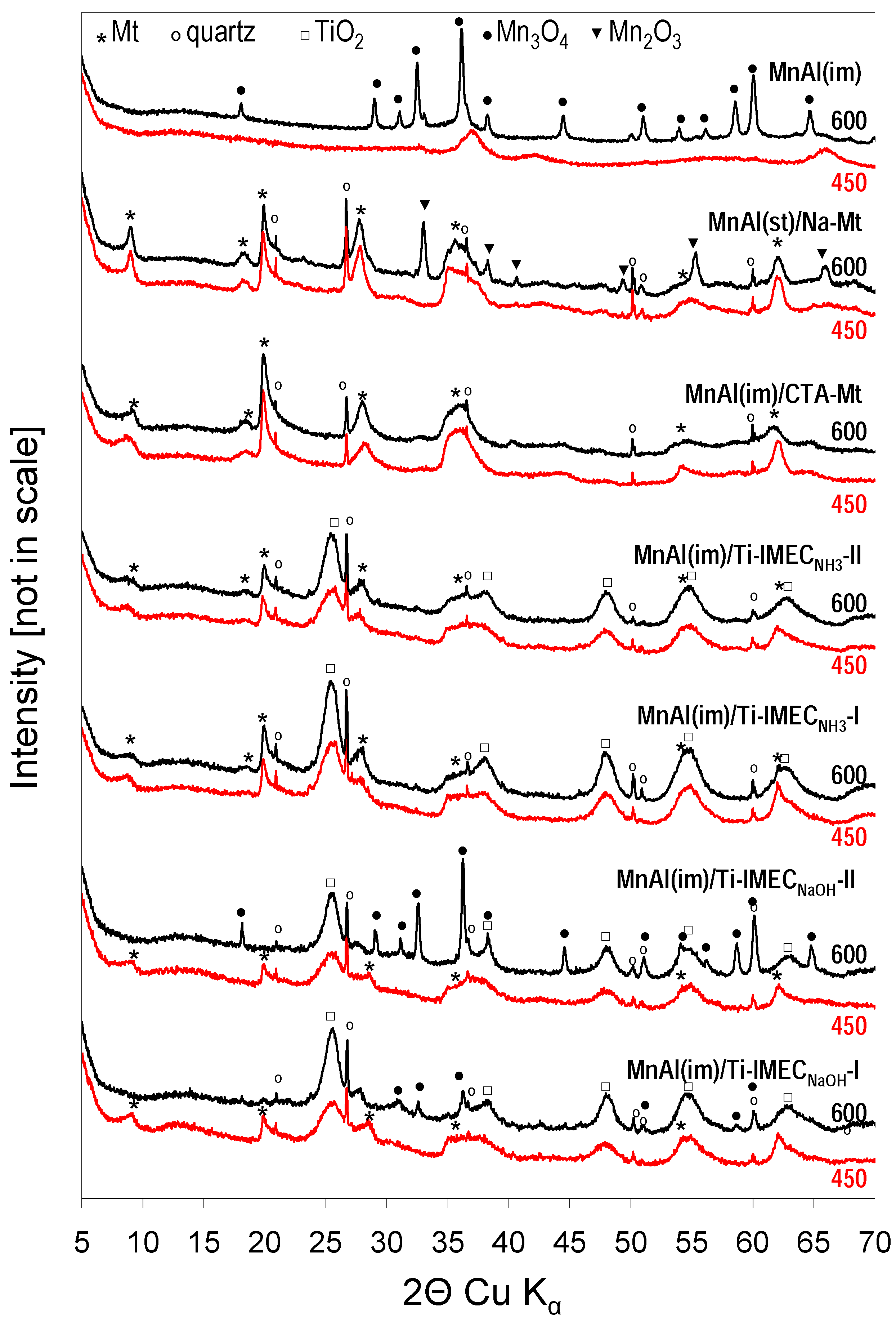
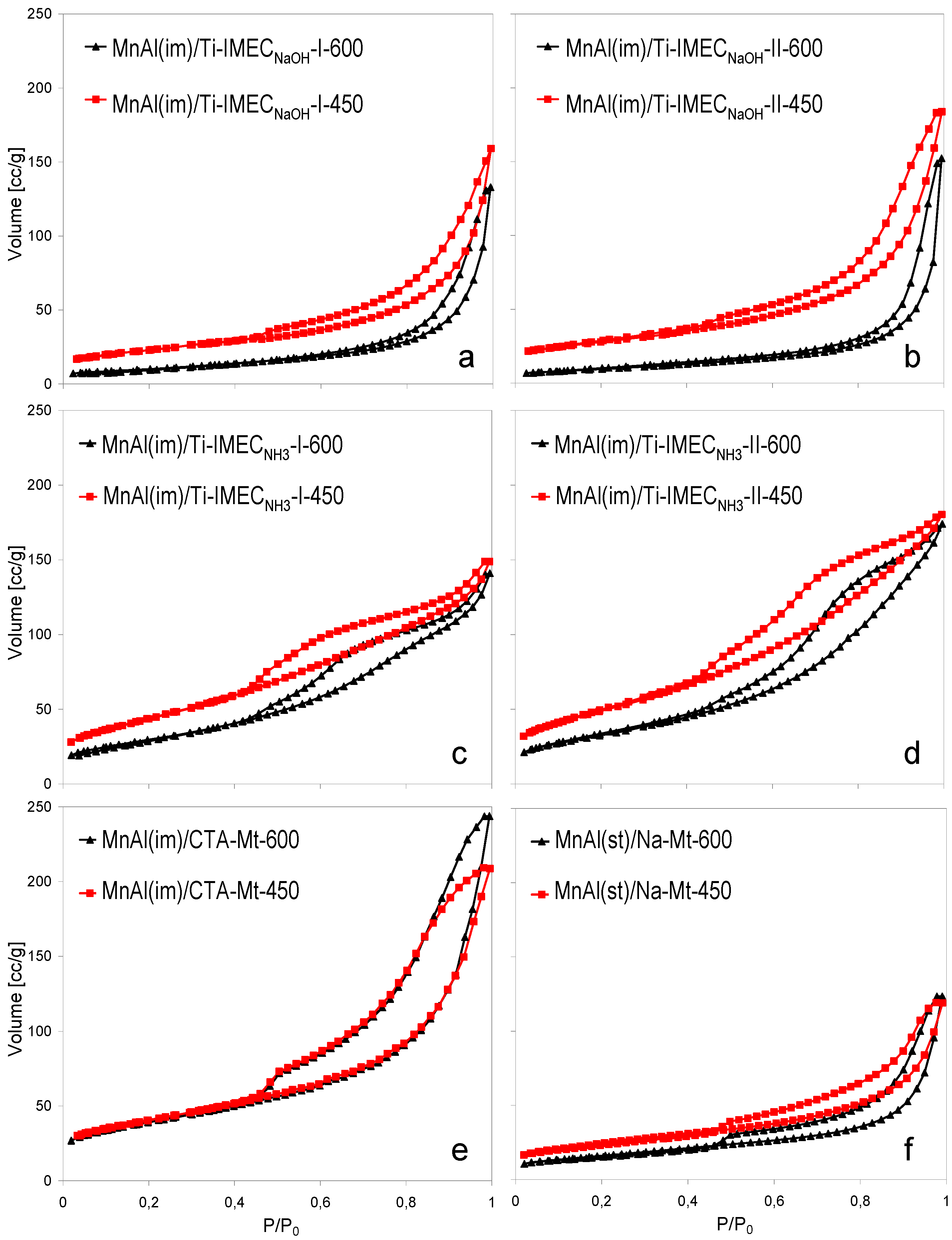
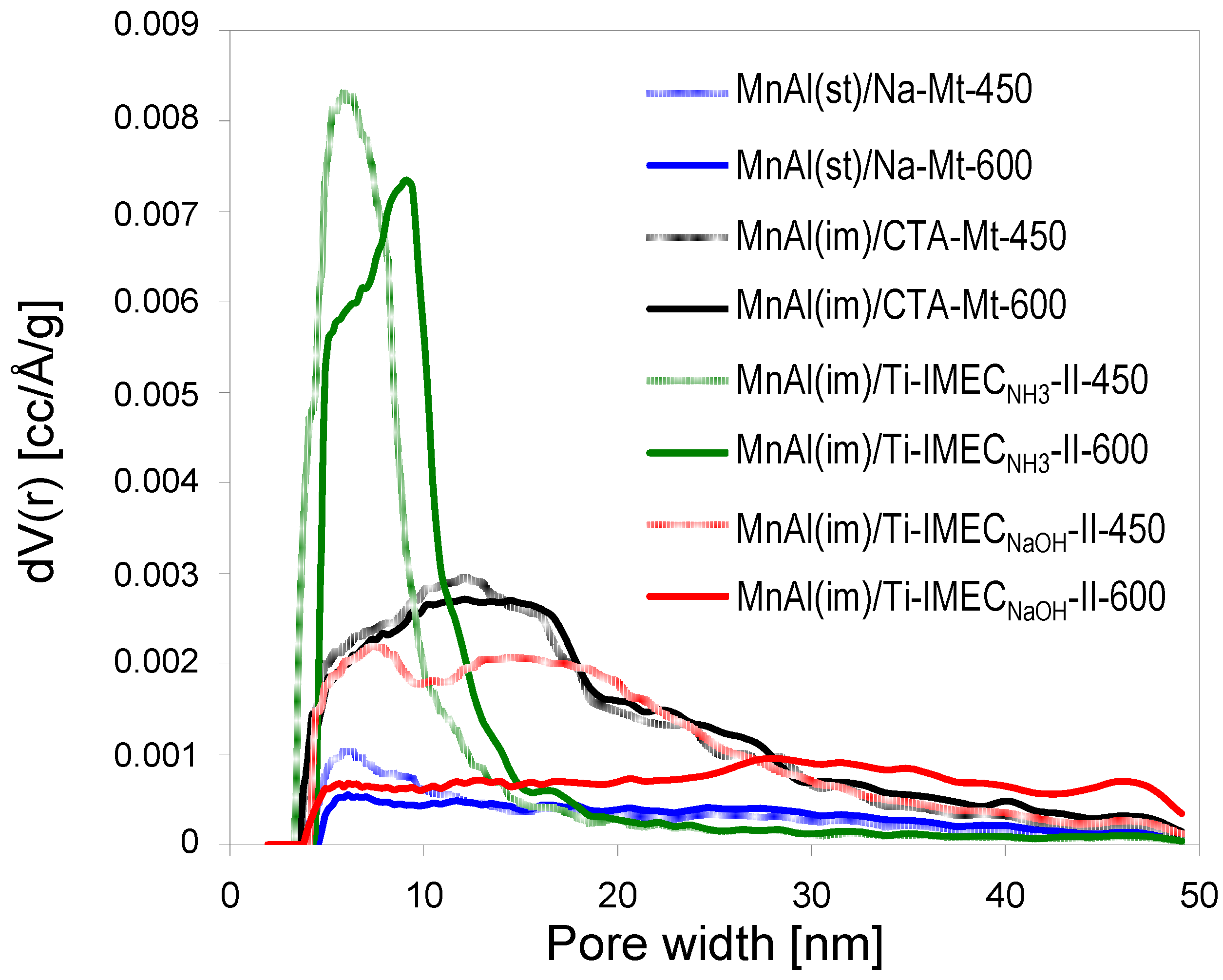
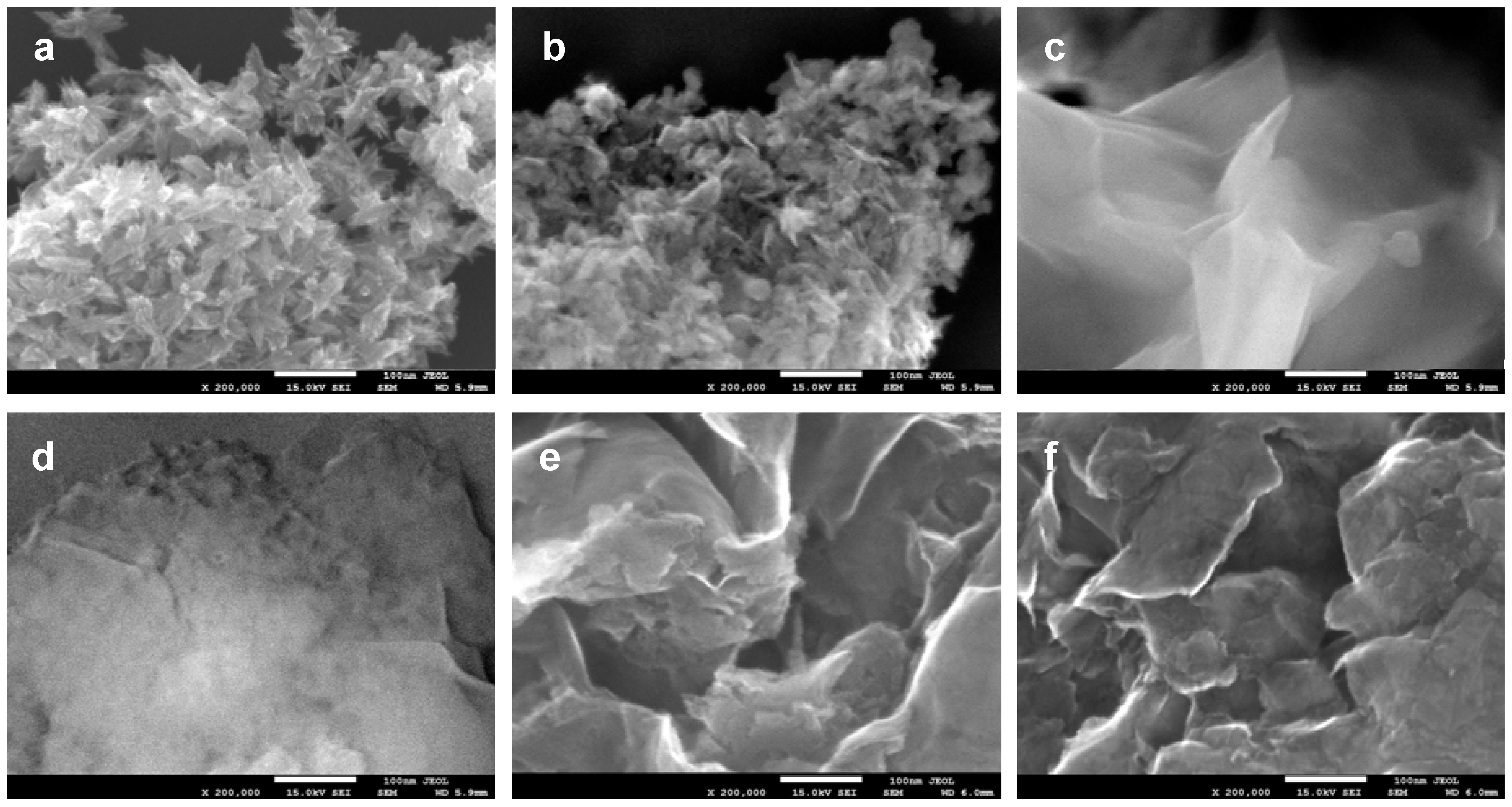
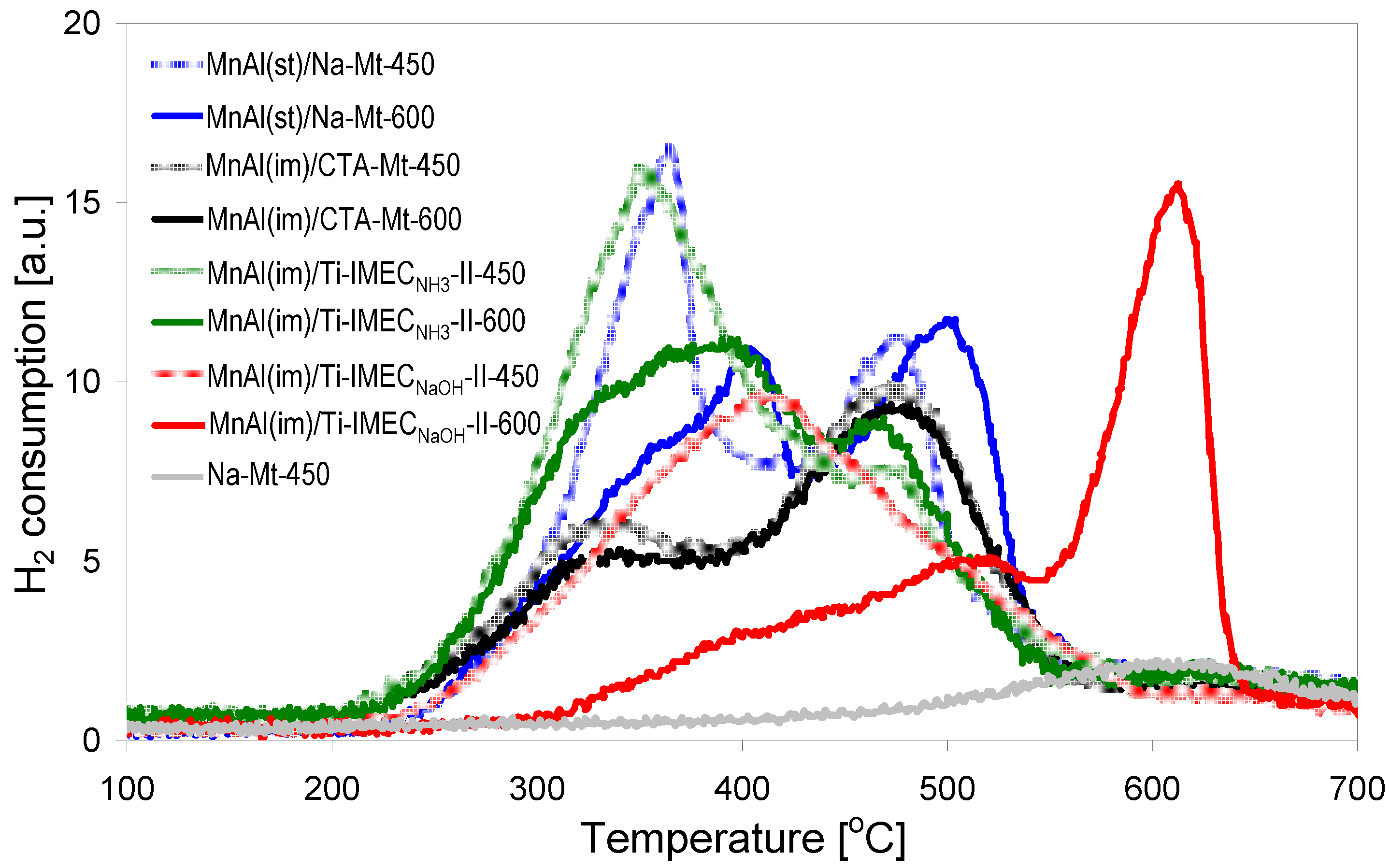
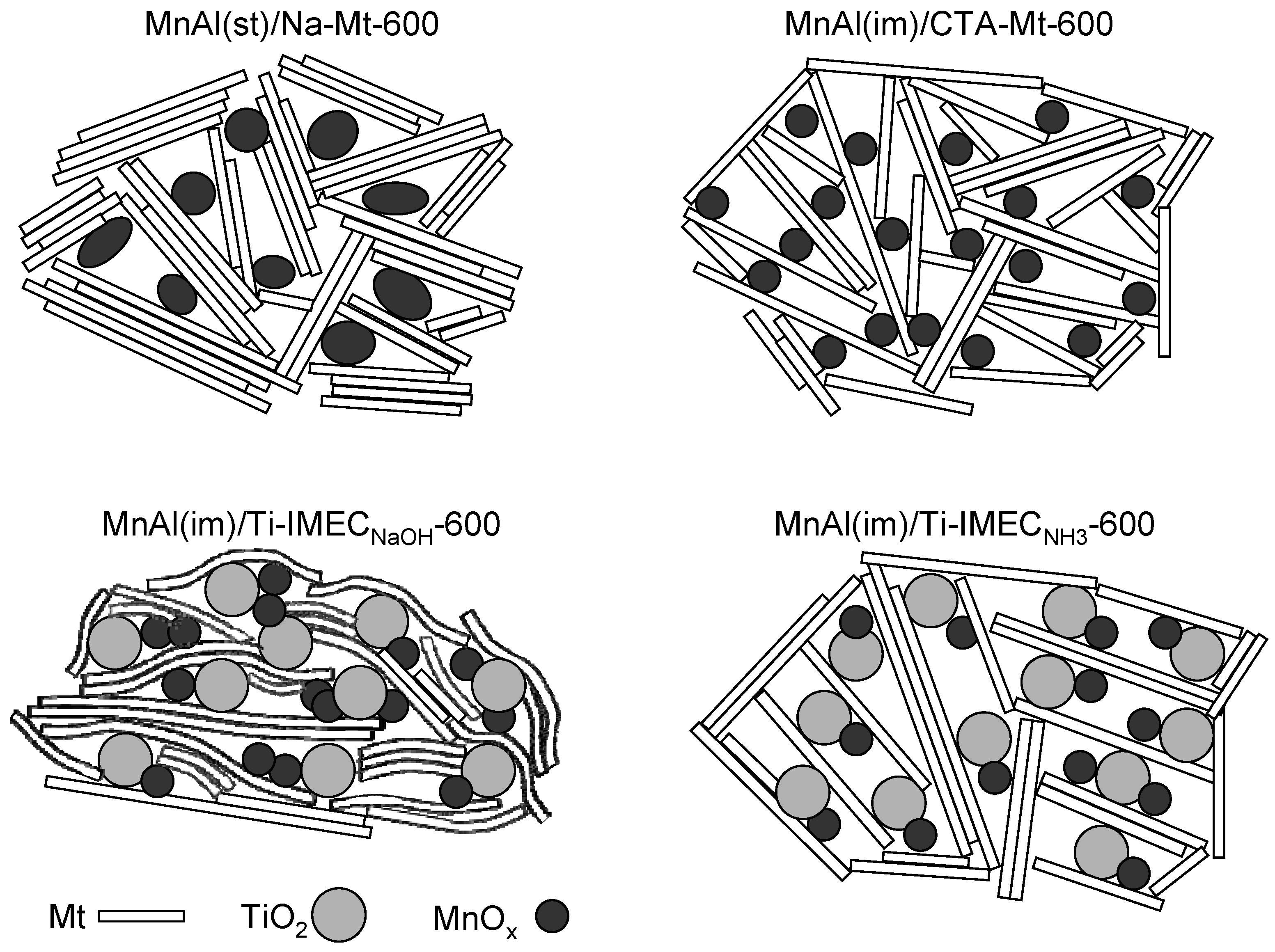
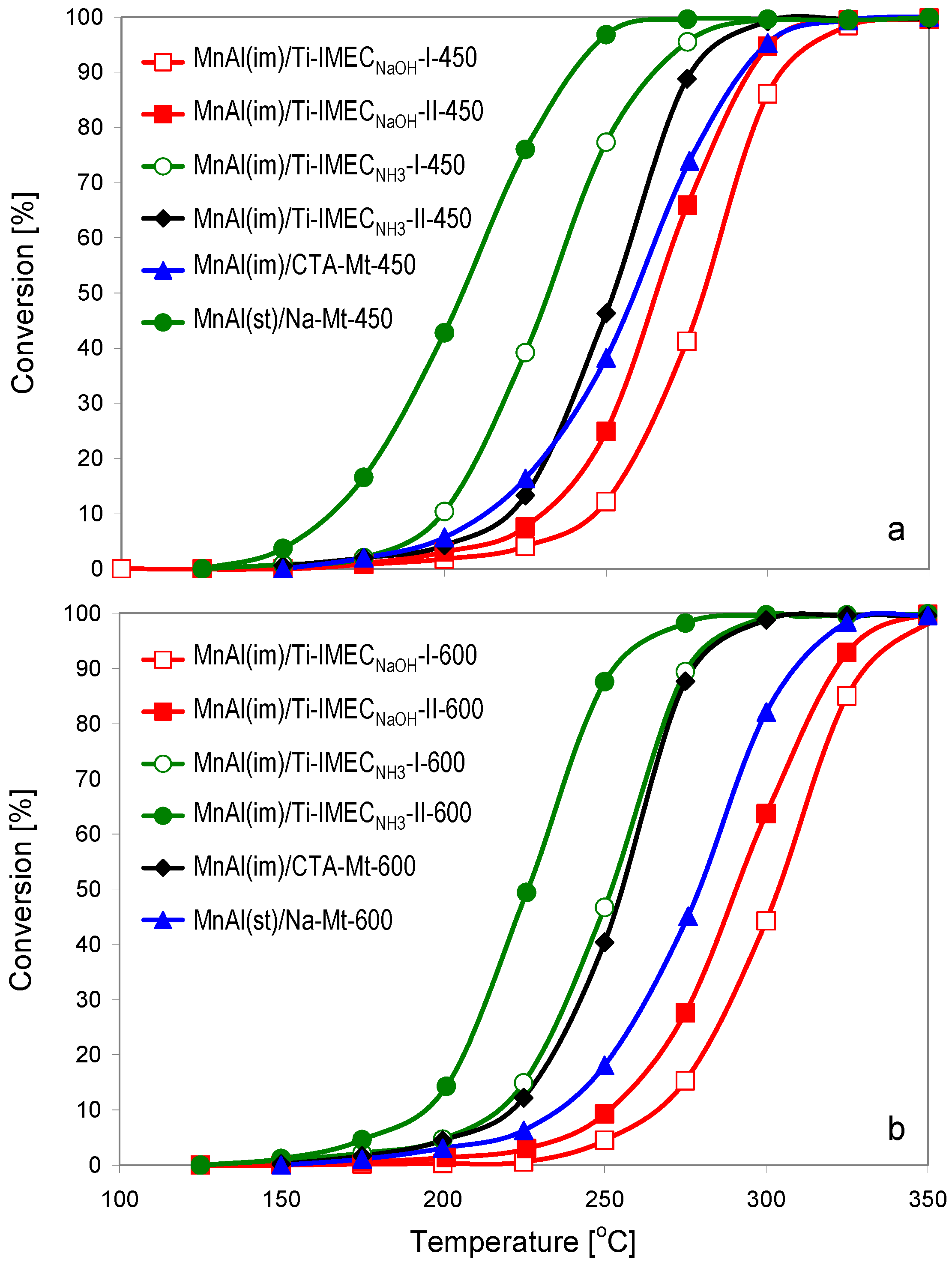
| Sample | SiO2 [wt%] | Al2O3 [wt%] | MgO [wt%] | TiO2 [wt%] | MnO [wt%] | Fe2O3 [wt%] | Na2O [wt%] |
|---|---|---|---|---|---|---|---|
| MnAl(im)/Ti-IMECNaOH-I | 30.3 | 12.3 | 1.6 | 38.3 | 7.3 | 1.3 | 7.8 |
| MnAl(im)/Ti-IMECNaOH-II | 24.9 | 12.4 | 1.4 | 33.0 | 18.2 | 1.2 | 7.9 |
| MnAl(im)/Ti-IMECNH3-I | 33.7 | 13.2 | 1.8 | 41.5 | 7.2 | 1.5 | - |
| MnAl(im)/Ti-IMECNH3-II | 28.5 | 13.8 | 1.5 | 36.6 | 17.5 | 1.3 | - |
| MnAl(im)/CTA-Mt | 49.2 | 26.0 | 2.9 | - | 18.5 | 2.3 | - |
| MnAl(st)/Na-Mt | 47.7 | 25.1 | 2.7 | - | 19.8 | 2.3 | 2.0 |
| Sample | SBET [m2/g] | Vtot [cm3/g] | Dav [nm] | Loop | H/Mn | T50 [°C] | T90 [°C] | ΔT50 [°C] | ΔT90 [°C] |
|---|---|---|---|---|---|---|---|---|---|
| MnAl(im)/Ti-IMECNaOH-I-450 | 81 | 0.25 | 12.25 | H3 | - | 280 | 304 | 24 | 27 |
| MnAl(im)/Ti-IMECNaOH-I-600 | 39 (48%) | 0.20 | 20.72 | H3 | - | 304 | 331 | ||
| MnAl(im)/Ti-IMECNaOH-II-450 | 90 | 0.28 | 12.53 | H3 | 1.1 | 265 | 295 | 26 | 27 |
| MnAl(im)/Ti-IMECNaOH-II-600 | 36 (40%) | 0.24 | 25.94 | H3 | 1.0 | 291 | 322 | ||
| MnAl(im)/Ti-IMECNH3-I-450 | 161 | 0.23 | 5.72 | H3/H5 | - | 232 | 265 | 20 | 10 |
| MnAl(im)/Ti-IMECNH3-I-600 | 108 (67%) | 0.22 | 8.09 | H3/H5 | - | 252 | 275 | ||
| MnAl(im)/Ti-IMECNH3-II-450 | 178 | 0.28 | 6.28 | H5 | 1.6 | 206 | 239 | 21 | 8 |
| MnAl(im)/Ti-IMECNH3-II-600 | 123 (69%) | 0.26 | 8.58 | H5 | 1.4 | 225 | 252 | ||
| MnAl(im)/CTA-Mt-450 | 132 | 0.33 | 10.08 | H3 | 1.1 | 252 | 275 | 3 | 2 |
| MnAl(im)/CTA-Mt-600 | 125 (95%) | 0.36 | 11.39 | H3 | 1.0 | 255 | 277 | ||
| MnAl(st)/Na-Mt-450 | 87 | 0.18 | 8.28 | H3 | 1.5 | 259 | 292 | 20 | 17 |
| MnAl(st)/Na-Mt-600 | 59 (68%) | 0.19 | 12.88 | H3 | 1.3 | 279 | 309 |
© 2017 by the authors. Licensee MDPI, Basel, Switzerland. This article is an open access article distributed under the terms and conditions of the Creative Commons Attribution (CC BY) license (http://creativecommons.org/licenses/by/4.0/).
Share and Cite
Napruszewska, B.D.; Michalik-Zym, A.; Rogowska, M.; Bielańska, E.; Rojek, W.; Gaweł, A.; Wójcik-Bania, M.; Bahranowski, K.; Serwicka, E.M. Novel Montmorillonite/TiO2/MnAl-Mixed Oxide Composites Prepared from Inverse Microemulsions as Combustion Catalysts. Materials 2017, 10, 1326. https://doi.org/10.3390/ma10111326
Napruszewska BD, Michalik-Zym A, Rogowska M, Bielańska E, Rojek W, Gaweł A, Wójcik-Bania M, Bahranowski K, Serwicka EM. Novel Montmorillonite/TiO2/MnAl-Mixed Oxide Composites Prepared from Inverse Microemulsions as Combustion Catalysts. Materials. 2017; 10(11):1326. https://doi.org/10.3390/ma10111326
Chicago/Turabian StyleNapruszewska, Bogna D., Alicja Michalik-Zym, Melania Rogowska, Elżbieta Bielańska, Wojciech Rojek, Adam Gaweł, Monika Wójcik-Bania, Krzysztof Bahranowski, and Ewa M. Serwicka. 2017. "Novel Montmorillonite/TiO2/MnAl-Mixed Oxide Composites Prepared from Inverse Microemulsions as Combustion Catalysts" Materials 10, no. 11: 1326. https://doi.org/10.3390/ma10111326





